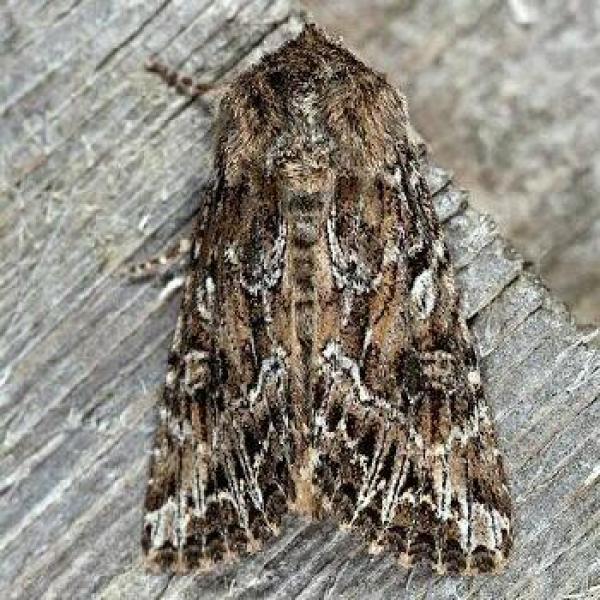Irregular Apamea
Apamea inordinata (Morrison, 1875)
- Class
- Insecta (Insects)
- Family
- Noctuidae (Owlet Moths)
- State Protection
- Not Listed
Not listed or protected by New York State.
- Federal Protection
- Not Listed
- State Conservation Status Rank
- S1
Critically Imperiled in New York - Especially vulnerable to disappearing from New York due to extreme rarity or other factors; typically 5 or fewer populations or locations in New York, very few individuals, very restricted range, very few remaining acres (or miles of stream), and/or very steep declines.
- Global Conservation Status Rank
- GU
Unrankable - Currently unrankable due to lack of information or due to substantially conflicting information about status or trends.
Summary
Did you know?
Apamea inordinata is included in a group of moths composed largely of North American apameine and noctuine Noctuidae. Most moths in this group are strong fliers. Individuals can easily travel a kilometer in half an hour, and 10 kilometers in a night.
State Ranking Justification
Forbes (1948) reported that this moth was extremely local. There are only two recent records of the moth in New York despite much trapping effort on the east end of Long Island near historical localities.
Short-term Trends
The short-term trend for this species in New York State is unknown. One individual was documented on one occasion on Robins Island in 1997. The species was also captured on eastern Long Island in 2007.
Long-term Trends
The long-term trend for this species is unknown. Forbes (1948) reported that the moth was extremely local. Despite much trapping effort on the east end of Long Island near historical localities, there are only a few recent records of the species.
Conservation and Management
Threats
The threats to this species in New York State are uncertain. Elimination and fragmentation of habitat by commercial and residential development are probably the most significant threats to this species.
Conservation Strategies and Management Practices
Minimizing lighting to maintain dark sky conditions would be beneficial.
Research Needs
Additional inventory is needed at suitable habitats (dry, often sandy, areas with grasses and/or sedges). Surveys should be conducted at blacklight at night from June to July.
Habitat
Habitat
This moth is found in dry, often sandy, areas that contain grasses and/or sedges.
Associated Ecological Communities
- Maritime dunes*
(guide)
A community dominated by grasses and low shrubs that occurs on active and stabilized dunes along the Atlantic coast. The composition and structure of the vegetation is variable depending on stability of the dunes, amounts of sand deposition and erosion, and distance from the ocean.
- Maritime heathland
(guide)
A dwarf shrubland community that occurs on rolling outwash plains and moraine of the glaciated portion of the Atlantic coastal plain, near the ocean and within the influence of onshore winds and salt spray.
- Sea level fen*
(guide)
A wetland that occurs at the upper edge of salt marshes but is fed primarily by acidic groundwater seeping out along the upland edge. This fresh water sometimes mixes with salt or brackish water during unusually high tides. There is a high abundance of sedges that decompose slowly and create a deep substrate of peat. This peat is underlain by deep sand or gravel. These fens usually have a high diversity of herbs but may also have scattered trees and shrubs.
* probable association but not confirmed.
Range
New York State Distribution
Currently, the only known occupied sites are on eastern Long Island and a nearby island. The moth is historically recorded from the eastern part of Long Island and Charlotte, New York.
Global Distribution
Distribution data for U.S. states and Canadian provinces is known to be incomplete or has not been reviewed for this species. The species is known to occur in North America in New York, Pennsylvania, Wyoming, Ontario, and Quebec (NatureServe 2010).
Best Places to See
- Napeague State Park (Suffolk County)
Identification Comments
Identifying Characteristics
This is a mostly brown moth. The forewing is patterned with various shades of brown and white. The wingspan is approximately 34 mm.
Best Life Stage for Proper Identification
The adult is the best life stage for identification.
Diet
The food source for the larvae is thought to be a grass or sedge.
Best Time to See
The best time to see this species is during its flight season, in June and July. It also comes to light rarely in October.
- Present
- Reproducing
The time of year you would expect to find Irregular Apamea present and reproducing in New York.
Irregular Apamea Images
Taxonomy
Irregular Apamea
Apamea inordinata (Morrison, 1875)
- Kingdom Animalia
- Phylum Arthropoda
(Mandibulates)
- Class Insecta
(Insects)
- Order Lepidoptera
(Butterflies, Skippers, and Moths)
- Family Noctuidae (Owlet Moths)
- Order Lepidoptera
(Butterflies, Skippers, and Moths)
- Class Insecta
(Insects)
- Phylum Arthropoda
(Mandibulates)
Comments on the Classification
Forbes (1948) uses the name Septis inordinata.
Additional Resources
References
Forbes, William T. M. 1948. Lepidoptera of New York and neighboring states part II. Cornell University Agricultural Experiment Station Memoir 274.
Forbes, William T. M. 1954. Lepidoptera of New York and neighboring states part III. Cornell University Experiment Station Memoir 329.
NatureServe. 2010. NatureServe Explorer: An online encyclopedia of life [web application]. Version 7.1. NatureServe, Arlington, Virginia. Available http://www.natureserve.org/explorer. (Data last updated August 2010)
New York Natural Heritage Program. 2024. New York Natural Heritage Program Databases. Albany, NY.
North American Moth Photographers Group at the Mississippi Entomological Museum. No date. Mississippi State University, Mississippi. http://mothphotographersgroup.msstate.edu/MainMenu.shtml
Schweitzer, Dale F. 1998. Rare, potentially rare, and historic macrolepidoptera for Long Island, New York: A suggested inventory list.
Links
About This Guide
Information for this guide was last updated on: February 8, 2012
Please cite this page as:
New York Natural Heritage Program. 2024.
Online Conservation Guide for
Apamea inordinata.
Available from: https://guides.nynhp.org/irregular-apamea/.
Accessed July 27, 2024.
